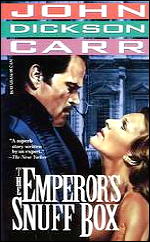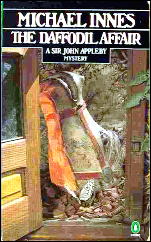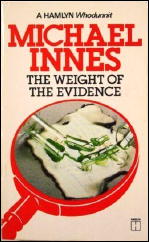Mon 5 Dec 2011
Reviewed by Marv Lachman: JOHN DICKSON CARR (1), MICHAEL INNES (2).
Posted by Steve under Reviews[6] Comments

JOHN DICKSON CARR – The Emperor’s Snuff-Box (Carroll & Graf, paperback reprint, 1986. Harper & Brothers, hardcover, 1942. Many other editions, both hardcover & paperback. Film: That Woman Opposite (UK, 1957) aka City After Midnight (US).
This book is best described by quoting Carr, himself, regarding the murder in it: “This is a domestic crime. A cozy, comfortable, hearth-rug murder.”
Though not the author at his best, this is typical Carr. There is love at first sight, and the setting is France, though most of the characters are British. There is less atmosphere than usual, and the puzzle is a bit less complicated, and therefore more guessable than most Carr’s.
None of Carr’s usual series characters are present; the murder is investigated by a French policeman and a vacationing British psychiatrist. The time is the summer of 1939 and the delight of a simpler time and an intriguing puzzle make this worthwhile, even if it is not Carr at his peak.

MICHAEL INNES – The Daffodil Affair. Penguin, paperback reprint, 1984. Several other paperback editions. Dodd Mead, hardcover, 1942.
— The Weight of the Evidence. Perennial Library, paperback reprint, 1983. Several other paperback editions. Dodd Mead, hardcover, 1943.
These books, original1y published in 1942 and 1943 respectively, come from the most imaginative period in the career of this writer who has been publishing mysteries for fifty years.
Daffodil is probably too wild and improbable for its own good, as we are asked to believe, on the basis of flimsy evidence, that Appleby and another Scotland Yard inspector would be sent out of war-time London into the jungles of South America.
The story begins attractively with the stolen titular horse and is heavy on human and animal psychology, accurately using the famous “Hans Legacy” about teaching horses tricks.

Finally, there is too little action and too unlikely an ending to justify what is otherwise an unusual and sophisticated book.
The Weight of the Evidence is relatively conventional for Innes, with its British university setting immediately before World War II, but it opens with an unpopular professor found crushed to death by a meteor.
It’s all very clever, but sometimes the literary allusions and sheer number of eccentric characters is a bit overdone. There’s a lot of good detection, though it is weakened by too much coincidence and a fortuitous confession at the end.
Vol. 8, No. 4, July-Aug 1986.
December 5th, 2011 at 5:07 pm
The summer of 1939- a simpler, delightful time ? Well….
The Doc
December 5th, 2011 at 5:29 pm
Well, Doc, it wasn’t until September 1st that all hell broke loose. So it *might* have been “a delight of a simpler time” in the summer of 1939.
Two of these books are special favorites. I have not read The Weight of Evidence, though I have read Thy Arm Alone by John Slate (AKA John Russell Fearn) which may be the only book in the genre that takes Innes’ unique murder method to the extreme.
I mentioned somewhere on this blog once before that The Emperor’s Snuffbox would’ve made a great movie and indeed it was as someone later pointed out to me.
The Daffodil Affair is to be admired for being an all-out surreal work that defies categorization and breaks all the “rules” of detective stories. I guess if you don’t like fantasy and demand cerebral detective work and hardcore realism in your detective novels you’d best avoid it. I still think it’s a landmark work in the genre.
December 5th, 2011 at 7:08 pm
As for the EMPEROR’S SNUFF BOX, it is one of the first 100 or so paperback mysteries I owned, the Berkley edition that came out in 1959. (I still have it.) I don’t remember it at all, so I have no idea whether Carr included any of the rumblings of war in it or not. Or if as sometimes happened back then, mystery fiction carried on its trade in its own isolated world. One thing’s for certain. I’m going to have to see if copies of the movie are still around. Thank goodness for the concept of collector-to-collector DVDs!
December 5th, 2011 at 7:01 pm
I’ll say this about THE DAFFODIL AFFAIR. It caught me by surprise, it truly did.
Here’s my review of the book, a long one, over 1000 words, with a lot of quotes taken directly from the book itself:
https://mysteryfile.com/blog/?p=1133
And here’s another quote. This one is me, taken from my review:
“I have to stop and tell you the truth right here, before going on any farther. I have never read a mystery or detective story that is ANYTHING like this one. In terms of being unique, this one’s the ultimate in uniqueness.”
December 7th, 2011 at 3:59 pm
THAT WOMAN OPPOSITE, the movie adapted from THE EMPEROR’SNUFF-BOX was released on a non regionally coded DVD earlier this year by Renown Pictures (www.renownpictures.com) a company specializing in 1940s and 1950s crime and comedy British second features and old TV series.
I watched it the other day and found it quite enjoyable; a polished though somewhat pedestrian production with a good cast but a somewhat dour lead in Dan O’Herlihy, whose profession had been changed to Insurance Investigator.
The sound and picture quality was excellent.
December 7th, 2011 at 4:06 pm
Thanks, Rob. Here’s a small correction to the website and a working link:
http://www.renownpicturesltd.com/
I’ve just found my way there. Haven’t had a chance to look around very long, but I’ve already spotted a dozen or so movies I wouldn’t mind having.